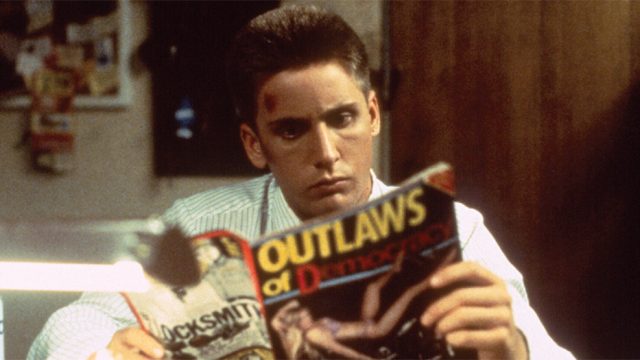Skip the Centerfold and Read About:
- a grimy movie
- modern cinematography
- a showstopping dance number
- sound over sight
- a windy city
- an anime legend
Thanks to scb0212 and Miller for contributing to this week’s text between the naughty pictures. Send articles throughout the next week to ploughmanplods [at] gmail, post articles from the past week below for discussion, and Have a Happy Friday!
At Inverse, Jake Kleinman brings an oral history of cult punk classic Repo Man:
Peter McCarthy: We had a cast and crew screening at the Fox Venice Theatre. The night of the screening, I look outside, and there’s 500 people. Then there’s more. It’s growing all the time. People start banging on the glass doors. It looked like the glass was going to break, so they finally just started flinging open the doors, and they all just came rushing into the theater like crazy. That theater was so full. Every fire hazard in the world was being violated. And I remember turning to Alex [Cox, writer/director] and just going, “Holy shit, the buzz on this thing is unbelievable. How do you think they’re going to react to it?” And Alex goes, “I hope they rip the seats out and throw it at the screen. I just hope they rip the theater apart.”
In The Los Angeles Review of Books, director of photography Michael M. Pessah discusses this year’s nominees for cinematography and how they make the most in challenging times for film:
One can’t help but notice that these films also feature a clever upcycling of earlier technologies. For example, VistaVision, a format most closely associated today with Alfred Hitchcock, was crucial in Poor Things. Rodrigo Prieto worked with Panavision to create lenses for Killers of the Flower Moon that evoke the John Ford films the picture references—a visceral reminder of how cinematographic technology develops in an additive way. We’ll happily utilize dizzying drone shots, but we’ll also rely on a camera being pushed along on a sled—just as we did 100 years ago.
Caitlin Huston for The Hollywood Reporter talks to choreographer Mandy Moore about staging the showstopping “I’m Just Ken” at last week’s Oscars:
Letting the Kens be like rock stars was also a big thing. Greta, on our initial Zooms, had just said, “My only dream for this is that everyone is up and singing at the end,” and so you have to create a performance that allows people to do that. And Simu did a video right before, on the commercial break, and told everyone it’s OK to get up and use your phones like you’re at a rock concert. […] It was mayhem. Ryan was so nervous, he was like, “Is nobody gonna stand up?” and I’m like, “Ryan, they’re gonna stand up. It’s going to be fine.” But that is a real thing, you get really nervous about that when you’re putting together something like this, where you’re basically making a rock concert, and if people didn’t stand up, it would fall very flat.
For Films In Frame, Dora Leu interviews Kiyoshi Kurosawa and talks about sound over image:
I’m always jealous of how free and luxurious sound is compared to the image. I think sound really has this broad capacity for expressing many things which the image may not be able to, because, through images, you can only show what’s there, there’s only so much you can add. Maybe I’m believing too much, but sound is truly a very luxurious thing. You can do so much with it, you can play with all sorts of possibilities, whether to create something realistic or non-realistic. Sound is more powerful. So, in terms of a hierarchy, sound is definitely on a higher level than the image. But with my films, I am not trying to surpass the image with sound. I want to add sound in such a way that it enriches the image, the visual part, but without going beyond it, surpassing it. If I go beyond it, then the image has no meaning at all.
At The Reveal, Keith Phipps yearns for the cinematic past of his adopted city:
Maybe it’s less nostalgia than disbelief. There’s a bit of egotism to this feeling. Seeing shots of the Chicago that used to be is a bit like seeing pictures of a romantic partner before you met them. Logically, of course they had a life before you. But in some respects that seems impossible. Didn’t their story begin when it joined yours?
And finally, Grant Jones eulogizes the recently departed anime pioneer Akira Toriyama at the Anime New Network:
The scale of his work and impact is truly massive. “Can they beat Goku?” is a perennial argument on playgrounds around the world. His loss has sparked times of mourning in national governments and been recognized by heads of state. It’s hard to find one aspect of his work that hasn’t become a lasting trope, inspired another creator, or permanently entered the popular lexicon. Akira Toriyama mentored entire generations of creatives who came after him, and his success challenged his peers to up their game and keep pace with his incredible work. […] He changed the lives of tens of millions of people – how can we measure up to that kind of legacy, even a little bit? How can you compete with that? That kind of influence and creativity can seem nearly divine. You can’t measure up to Akira Toriyama – no one can beat Goku, it seems.

